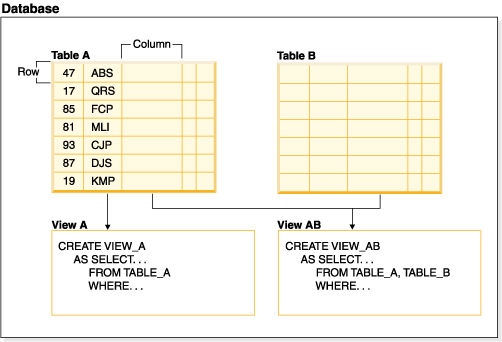Views
A view is an efficient way of representing data
without the need to maintain it. A view is not an actual table and
requires no permanent storage. A virtual table
is created and
used.
A view provides a different way of looking at the data in one or more tables; it is a named specification of a result table. The specification is a SELECT statement that is run whenever the view is referenced in an SQL statement. A view has columns and rows just like a table. All views can be used just like tables for data retrieval. Whether a view can be used in an insert, update, or delete operation depends on its definition.
A view can include all or some of the columns or rows contained in the tables on which it is based. For example, you can join a department table and an employee table in a view, so that you can list all employees in a particular department.
Figure 1 shows the relationship between tables and views.

You can use views to control access to sensitive data, because views allow multiple users to see different presentations of the same data. For example, several users might be accessing a table of data about employees. A manager sees data about his or her employees but not employees in another department. A recruitment officer sees the hire dates of all employees, but not their salaries; a financial officer sees the salaries, but not the hire dates. Each of these users works with a view derived from the table. Each view appears to be a table and has its own name.
When the column of a view is directly derived from the column of a base table, that view column inherits any constraints that apply to the table column. For example, if a view includes a foreign key of its table, insert and update operations using that view are subject to the same referential constraints as is the table. Also, if the table of a view is a parent table, delete and update operations using that view are subject to the same rules as are delete and update operations on the table.
A view can derive the data type of each column from the result table, or base the types on the attributes of a user-defined structured type. This is called a typed view. Similar to a typed table, a typed view can be part of a view hierarchy. A subview inherits columns from its superview. The term subview applies to a typed view and to all typed views that are below it in the view hierarchy. A proper subview of a view V is a view below V in the typed view hierarchy.
A view can become inoperative (for example, if the table is dropped); if this occurs, the view is no longer available for SQL operations.